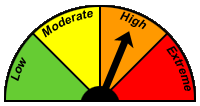Important!
- Water is essential for survival.
- In an emergency it is vital that all household members learn how to shut off the main water valve: at the well pressure tank or the line coming into the house.
- Storing an alternative supply of water is also essential.
Preparing to Shut Water Off
- Locate the shut-off valve for the water line that enters your home or at the well pressure tank.
- Make sure this valve can be completely shut off. Your valve may be rusted open, or it may only partially
close. Replace it if necessary. - Label this valve with a tag for easy identification, and make sure all household members know where it is
located.
Amount to Store
Store 2.5 litres to 5 litres per person per day. Seven days is the absolute minimum for which you should be
prepared. This water will be required for drinking, food preparation, washing dishes, brushing teeth and other hygiene needs. (You can flush a toilet with a bucket of raw lake or creek water.)
How to Store Emergency Water
- Store water in sturdy, opaque plastic food-grade pails, jugs or bottles. Plastic soft drink containers work
well for short-term storage but use opaque jugs available from camping supply stores or water distributors
for long-term storage. Bundles of commercially bottled water are best kept in the dark or covered. It is recommended to store water containers on wood rather than directly on concrete floors. - Before filling, rinse the inside of the storage bottle thoroughly. Add a few drops of chlorine bleach OR
vinegar OR baking soda (NOT TOGETHER) to some rinse water and shake well. Empty the bottle and fill
with fresh water to the very top. - Date the bottle and label it “Purified Drinking Water.”
- Store bottles in cool, dark locations (up off cement floors). Storing some in freezers can provide additional
water and help keep food frozen longer should the power be off for an extended period of time. - Water supplies should be replaced every six months.
- Avoid storing in areas where toxins like gasoline and pesticides are stored. These vapours can penetrate
the plastic over time.
Additional Sources of Drinking Water
- Hot water heaters.
- Existing water in plumbing (may need to be purified).
- Melted snow and nearby lakes or creeks will need to be purified.
- Do NOT drink water bed, hot tub or swimming pool water. (See CAUTION below!)
Purifying Water for Immediate Needs
- First, strain out any sediment or particles from the water by pouring it through several layers of paper
towels, cheesecloth, or coffee filters. - Then, use ONE of the following purification methods.
- Boil the water for 10 minutes.
- Add liquid household bleach (must contain 5.25% sodium hypochlorite and be less than one year old)
in these amounts:
| Water Amount | If Water is Clear Add: | If Water is Cloudy Add: |
|---|---|---|
| 1 litre | 2 drops | 4 drops |
| 5 litres | 5 – 8 drops | 16 drops |
| 25 litres | 1/2 teaspoon | 1 teaspoon |
- Commercial water purification tablets (like AQUATABS®) may be used, but some have a limited shelf life,
so make sure you note the expiration date and replace them regularly. - If you are a hiker/camper you may already own a portable water purification system. Make sure it is
well-maintained and you know where it is.
Notice
Caution!: Do not drink water from swimming pools, hot tubs or water beds. The high concentration of chemicals salts and/or chlorine can cause serious health problems. Use for washing, cleaning and flushing purposes only.





